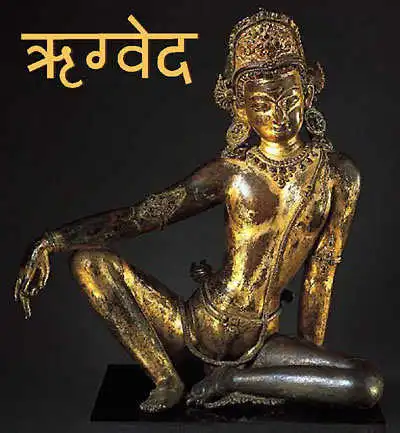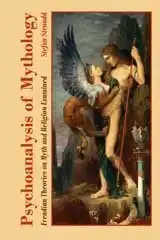
The Creation in Rig Veda 10:129H. H. Wilson's Translation
H. H. Wilson's Version of Rig Veda 10:129Horace Hayman Wilson (1786-1860) was an English orientalist who lived many years in India and translated several Sanskrit texts. He was the first to make a translation of the complete Rig Veda (Rig-Veda Sanhitá: A Collection of Ancient Hindu Hymns), which was published in six volumes during the years 1850-88. So, he was dead long before the last volume was printed.
It's in the sixth and last of the volumes that Rig Veda 10:129 is found, but not with that title. Wilson used a different system of organizing the hymns, in which this one was: Anuva'ka XI, Adhya'ya VII, Súkta I (CXXIX), Varga XVII. The translation is richly commented, mainly by extensive footnotes, in which he mostly expressed the opinion of Sayana, a prominent 14th century commentator on the Veda scriptures, whose comments were also published in the Max Müller Sanskrit edition of the Rig Veda (Rig-Veda-Samhita: The Sacred Hymns of the Brahman, 1849-74). Contrary to Max Müller in his English version of the hymn (A History of Ancient Sanskrit Literature, London 1859, p. 564), H. H. Wilson divided it into seven verses. The same has been done by every translation to follow, as far as I have seen. His system of sorting the Rig Veda hymns, though, seems to have no follower.
The Author of the Creation and of the HymnH. H. Wilson introduces the Rig Veda 10:129 hymn by stating (p. 350): "The deity is Paramátmá, the author of the creation, preservation and dissolution of the various entities (bhávas), these being the subjects treated in the hymn; the Rishi is Paramátmá, under his appellation Parameshthin."Paramátmá, the Supreme Soul, is a Vedic deity. Parameshthin, who stands in the highest place, is a title to distinguish superiority, and rishi is what the poets of the Vedic hymns are called.
 Horace Hayman Wilson, portrait by unknown artist. So, Wilson would have it that Paramátmá was regarded as the initiator of the creation as well as the one revealing the text of the hymn, as if by writing it. This may be the opinion of Sayana, but the hymn itself suggests little of it. Since it actually questions a conscious and intentional creation, it would be odd if a certain deity was meant. Instead, the Rig Veda 10:129 hymn is the speculation of a human mind, bewildered by it all. With the many doubts and uncertainties it expresses, the hymn is as far from a divine edict as one can get. This Rig Veda hymn is not a piece of mythology, but a meditation on the paradox of creation. Here is H. H. Wilson's translation of Rig Veda 10:129 in its entirety (p. 350ff), which presents each verse like prose, without line breaks, contrary to most other translators:
Rig Veda, Mandala 10, hymn 129(Anuva'ka XI, Adhya'ya VII, Súkta I (CXXIX), Varga XVII)Creation. Nasadiya Sukta ("Not the non-existent")
2. Death was not nor at that period immortality, there was no indication of day or night; THAT ONE unbreathed upon breathed of his own strength, other than THAT there was nothing else whatever. 3. There was darkness covered by darkness in the beginning, all this (world) was undistinguishable water; that empty united (world) which was covered by a mere nothing, was produced through the power of austerity. 4. In the beginning there was desire, which was the first seed of mind; sages having meditated in their hearts have discovered by their wisdom the connexion of the existent with the non-existent. 5. Their ray was stretched out, whether across, or below, or above; (some) were shedders of seed, (others) were mighty; food was inferior, the eater was superior. 6. Who really knows? who in this world may declare it? whence was this creation, whence was it engendered? The gods (were) subsequent to the (world's) creation; so who knows whence it arose? 7. He from whom this creation arose, he may uphold it, or he may not (no one else can); he who is its superintendent in the highest heaven, he assuredly knows, or if he knows not (no one else does).
Unbreathed UponSubstantially, the Wilson version of Rig Veda 10:129 is very close to that of Max Müller, which I have presented previously. Most of the differences are synonyms or altered orders of words. The content remains the same. But there are some deviations that suggest differences of opinion on how to understand parts of the hymn.The first significant deviation regards the breath of the One, whom H. H. Wilson with uppercase letters calls THAT ONE. Max Müller says that he "breathed breathless," whereas Wilson writes that the One "unbreathed upon breathed of his own strength." To be unbreathed upon is simply to be the first, born and bred by none. To breathe breathless, on the other hand, suggests another kind of existence than the worldly one in which breath is essential to life and ends simultaneously. Both writings point out a primordial deity, but with differing arguments.
AusterityAs for the initial emergence of what was to be the world, Max Müller mentions a "germ" bursting forward from "fervent heat." H. H. Wilson on the other hand has "austerity" as the primal power initiating creation in the void.That's a strange choice of word, not repeated in other translations. He explains it in a footnote (p. 351): "Tapas is said to mean not penance, but the contemplation of the things which were created." It still makes little sense.
 Indra. Sculpture from Nepal, 16th century. Having contemplation, pure thought, being the ignition of the creation makes it similar to Genesis 1 of the Bible, where God creates from his mind by simply saying: "Let there be..." Maybe Wilson was influenced by the Christian context quite present in his society. It would fit better with other translations of Rig Veda 10:129 if austerity here meant something like contraction or compression, which would indeed increase the temperature. But that's something we've learned from modern physics. We can't take for granted that it was known 3,000 years ago in India, when this Rig Veda hymn was written.
Desire Instead of LoveH. H. Wilson is more credible, though, in the next deviation from Max Müller's version of Rig Veda 10:129. He chooses "desire" instead of "love" as the driving force in the continued development of the world. Here he agrees with most translators to precede him.Müller was quite aware of this word's relevance, but his poetic version of the Rig Veda hymn used another, maybe simply to avoid becoming profane. Wilson calls desire "the first seed of mind." Indeed, it's the engine behind will-power in all living things. A craving of whatever kind pushes us into action. Without the desire for something, we would be unable to seek it.
Eat or Be EatenAs for the continued impulse of creation, Müller calls it a spark and Wilson a ray, which is almost the same. They both describe a division of the world into high and low, strong and weak. Wilson uses a grim polarity – that between food and eater.It's a traditional view in European society that superiority is decided by who eats whom. The second creation story of the Bible, Genesis 2, states clearly that the animals are created to serve man in one way or other. Man is to be the food of no beast, thereby proving to be the crown of creation. This reasoning is not only biblical, but can be found in many societies – especially those with agriculture, since that became a much more methodical exploitation of nature than in hunter-gatherer societies. The society in which Rig Veda 10:129 emerged was certainly an agricultural one. Its writer as well as its contemporary readers would have no problem understanding the statement. In a footnote (p. 352), H. H. Wilson adds a perspective to the world division into opposite directions by that initial ray. He takes it from Sayana, who claimed that the description refers to "the suddenness of creation" and that "creation took place simultaneously in all three portions of the universe." This comes close to our modern understanding of the Big Bang, although Wilson's text preceded our knowledge of it with several decades and Sayana's comments date hundreds of years earlier. But it's not unfathomable in the Judeo-Christian tradition, familiar with the idea of God filling the whole world, day by day, with different things. When he ordered light, the whole universe was instantly lit as it is now. As for Indian cosmology at the time of Sayana, there were hardly any unfathomable perspectives on the emergence and nature of the cosmos.
The Joke All But GoneThe last part of the Rig Veda 10:129 hymn, ending with the paradox that almost seems like a joke, has a complicated form in H. H. Wilson's version, almost spoiling the pun of the very last line. He makes it double: only the creator can uphold creation, and only the creator can know from what it arose.Well, actually the joke is gone, replaced by what comes close to tautology. Of course, if the only one who can will not, nobody else can do it instead. Otherwise he wouldn't be the only one. In Max Müller's version, the paradox of even the creator being ignorant of the origin of the creation stands out, but it's lost with Wilson. Later translations are much closer to Müller in this case, which is fortunate. Without the ending punch line, Rig Veda 10:129 would lose a lot of its charm. What H. H. Wilson focuses on, instead, is the cosmology implied by the hymn, and the mythology behind it. I doubt that his approach is the most rewarding one, since it's still hard to abandon the strong impression that the hymn was written as a reflection on the very paradox of creation, about which even a creator god would be dazed.
About R. T. H. Griffith's Translation of Rig Veda 10:129The Creation in Rig Veda 10:129The Paradox of Origin
MENUCreation Myths Around the WorldHow stories of the beginning began.
The Meanings of MythologyTheories through history about myth and fable.
Archetypes in MythsThe mythological symbols and what they stand for.
The Logics of MythPatterns of creation.
CREATION MYTHS IN DEPTHCreation in Rig Veda 10:129The paradox of origin, according to an Indian myth.
Genesis 1The first creation story of the bible scrutinized.
Enuma ElishThe ancient Babylonian creation myth.
Xingu Creation of ManThe insoluble solitude of gods and humans.
ContactAbout Cookies
ON MY OTHER WEBSITESPsychoanalysis of MythWhat Sigmund Freud and C. G. Jung thought about myths, their origins and meanings.
Myth of CreationAn introduction to the subject of creation myths and the patterns of thought they reveal.
Cosmos of the AncientsWhat the Greek philosophers believed about the cosmos, their religion and their gods.
Life EnergyThe many ancient and modern life force beliefs all over the world explained and compared.
TaoisticTaoism, the ancient Chinese philosophy of life explained. Also, the complete classic text Tao Te Ching online.
|
 Archetypes of Mythology
Archetypes of Mythology Psychoanalysis of Mythology
Psychoanalysis of Mythology Cosmos of the Ancients
Cosmos of the Ancients Life Energy Encyclopedia
Life Energy Encyclopedia Sunday Brunch with the World Maker
Sunday Brunch with the World Maker Fake Lao Tzu Quotes
Fake Lao Tzu Quotes Stefan Stenudd
Stefan Stenudd